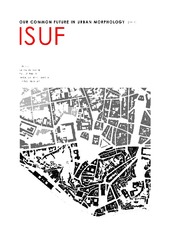| dc.creator | Niković, Ana | |
| dc.creator | Đokić, Vladan | |
| dc.creator | Manić, Božidar | |
| dc.date.accessioned | 2019-11-03T16:55:35Z | |
| dc.date.available | 2019-11-03T16:55:35Z | |
| dc.date.issued | 2014 | |
| dc.identifier.isbn | 978-972-99101-5-9 | |
| dc.identifier.uri | http://raumplan.iaus.ac.rs/handle/123456789/378 | |
| dc.identifier.uri | https://raf.arh.bg.ac.rs/handle/123456789/410 | |
| dc.description.abstract | The aim of this paper is to present one of the main issues and tasks of the ISUF – the importance of introducing concepts of urban morphology to professional practice, in a systematic and coherent way, to achieve a better built environment - in the specific context of Belgrade’s designing and planning practice. Á review of relevant up-to-date research topics and developed concepts found in the current theoretical discourse presented in the Urban Morphology Journal and ISUF, such as: morphological dimension of municipal plans (Oliveira, 2006, 2013), the issue of boundaries (Whitehand, 2007, 2013; Larkham, 2011; Morton), the question of scale and key concept – block or tissue (Kropf, 2006, 2011; Samuels, 2008; Hall, 2008a, 2008b) will be conducted. A number of major themes in the agenda of the morphological debate, will be examined to establish how existing morphological criteria in the Master plan of Belgrade and related planning documents correspond. It was determined that the morphological dimension of those criteria is questionable and that the real form-based approach in Belgrade’s planning documents and procedures were absent which had a detrimental impact on the quality of physical and urban structure. It can be stated that there is a need, firstly, for a detailed theoretical elaboration of relevant concepts of urban morphology and then integrating them into planning documents and procedures in Belgrade and Serbia. The principal conclusion reached is that urban morphologists should have a key role in the prescription of future changes through coordination of design guidance, codes and plans at different scales. | en |
| dc.language.iso | en | sr |
| dc.publisher | Porto : FEUP | sr |
| dc.relation | info:eu-repo/grantAgreement/MESTD/Technological Development (TD or TR)/36036/RS// | sr |
| dc.rights | openAccess | sr |
| dc.rights.uri | https://creativecommons.org/licenses/by-nc-nd/4.0/ | |
| dc.source | Our common future in Urban Morphology. Vol. 1, Book of Abstracts | sr |
| dc.subject | Belgrade | sr |
| dc.subject | urban morphology | sr |
| dc.subject | urban form | sr |
| dc.subject | planning | sr |
| dc.subject | designing | sr |
| dc.title | The morphological dimension of planning documents: case study Belgrade, capital of Serbia | en |
| dc.type | conferenceObject | sr |
| dc.rights.license | BY-NC-ND | sr |
| dcterms.abstract | Никовић, Aна; Манић, Божидар; Ђокић, Владан; | |
| dc.citation.spage | 405 | |
| dc.citation.epage | 405 | |
| dc.description.other | Abstract presented at the 21st International Seminar on Urban Form, held 3-6 July 2014 in Porto | en |
| dc.identifier.fulltext | https://raf.arh.bg.ac.rs/bitstream/id/783/bitstream_783.pdf | |
| dc.identifier.rcub | https://hdl.handle.net/21.15107/rcub_raf_410 | |
| dc.type.version | publishedVersion | sr |

